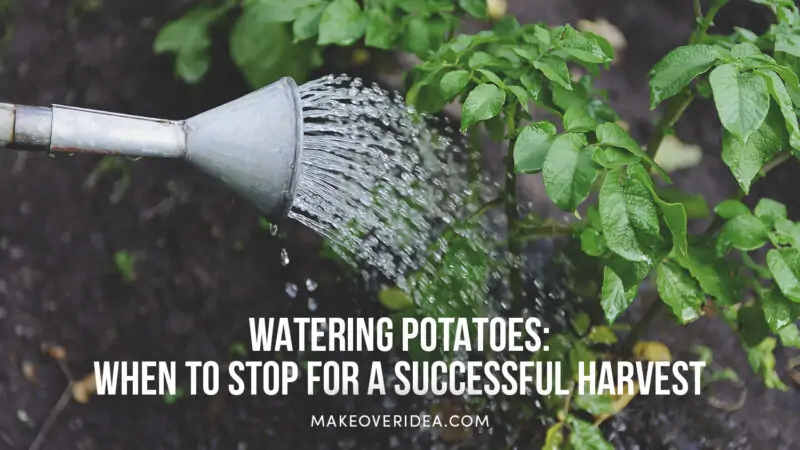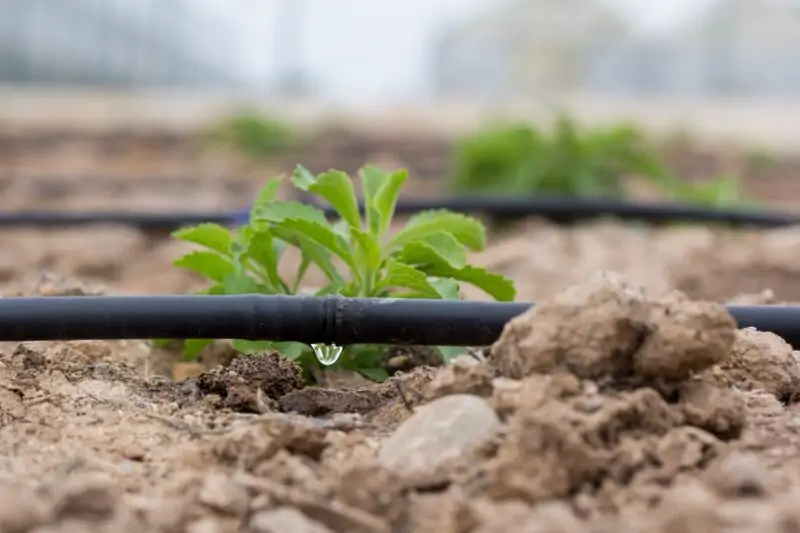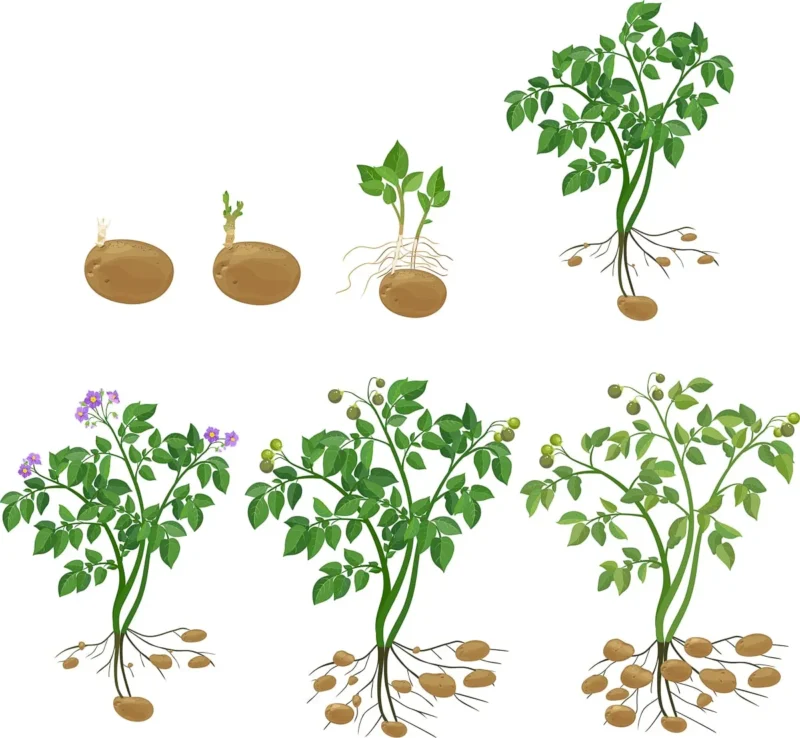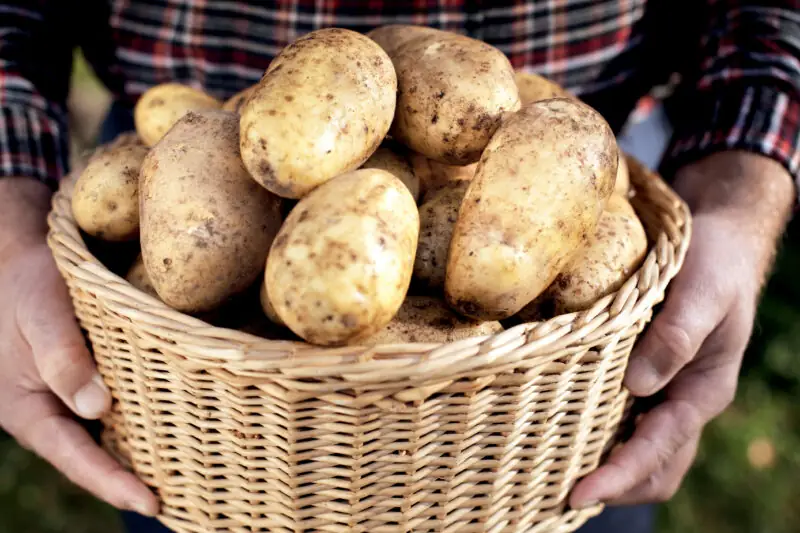When to Stop Watering Potatoes for an Abundant Harvest

When to stop watering potatoes? Every passionate gardener, knows that these plants only seem to be easy to grow. Growing your tubers to perfection requires attention to every detail, from planting techniques to watering schedules. In this article, we’ll discuss when exactly you should stop watering during the growth cycle which is one of the most critical aspects of potato growing.
Why Watering Potatoes Is Important for Their Growth
Growing perfect potato tubers starts by providing them with the right amount of water at precisely timed intervals throughout their growing cycle.
How Much Water Do Potatoes Need?
Potatoes are susceptible plants that require enough moisture but can’t withstand excessively wet soil conditions or being flooded with a lot of water because it promotes root rot fungus.
How much water they need in general? It depends on numerous factors like weather conditions and climate zone; however, generally speaking, they need 1 inch of water per week depending on the medium level of humidity present in an area. If your climate, however, is slightly more dry, 2 inches of water per week might be required. A good technique would be inserting a shovel into your garden bed’s earth down six inches to determine whether there’s adequate dampness or not.
Properly moist soil allows thousands of tiny hair-like roots of each plant to easily absorb nutrients. Frequent watering, on the other hand, causes leaching or washing excess minerals away. This results in deeply rooted, healthy crops, ensuring your success and larger potatoes per plant!
Watering Techniques for Potatoes

The easiest way to water your potatoes is by using sub-level drip irrigation. This method allows for efficient watering without causing any harm to the plants. It is essential to provide enough water to the plants while avoiding overwatering, which can lead to root rot and other issues.
When to Stop Watering Your Potato Bed: Key Factors
Knowing the correct timing of when you should stop watering your potato plants is incredibly important in ensuring a great-looking crop of potatoes. The aim of any gardener is to balance moisture and soil conditions while preventing over- or underwatering by understanding key factors.
Potato Plant Growth Stages

It’s essential first to understand that potatoes’ maturation periods occur roughly seventy days after cuttings emerge from underground. The ideal period for stopping watering your plants depends on climate zones and rainfall patterns in your region, allowing for adequate irrigation techniques while avoiding excessive moisture.
Climate and Weather Considerations
When balancing water supply against drainage systems in vegetation, make sure there are no threats from intense weather changes, especially during growing seasons. Keep an eye on humidity levels and adjust your watering schedule accordingly to ensure a healthy and bountiful harvest.
Preparing for Potato Harvest
Potato harvesting requires attention to detail and proper timing. It’s crucial to monitor the development of your potatoes and adjust your watering schedule accordingly.
Signs Your Potatoes Are Ready to Harvest
Signs indicating readiness will differ depending on species, but you can spot them by observing yellowed plants around eight weeks after having planted potatoes in your home garden. Look for thickened, dry roots as an indicator that it’s time to harvest.
The Role of Watering in Tuber Development
As potatoes develop, proper watering is crucial. Regular and consistent irrigation during their growth period positively affects the uniformity, size, and quality of potato production, whether you grow your potatoes in raised beds or directly plant them in the ground of your home garden.
Watering Rules and Common Mistakes
Good practices are essential to growing perfect potatoes. To answer the question of how often should you water potatoes, it is necessary to take a look at common mistakes to avoid when it comes to watering your row of potatoes.
Overwatering and Root Rot
Over-watered soil often causes the potatoes to rot in the ground, which can halt absorption and cause nutritional issues, ultimately damaging your crops and resulting in a poor potato harvest. Avoid watering the plants too frequently by monitoring soil dampness and ensuring proper drainage or your plants will start rotting.
Underwatering and Stunted Growth
Even if you want to avoid your plants to get flooded with water, you still need to keep in mind that your plants need watering to be sufficient: do not keep your potatoes without moisture! Inadequate water supply throughout the growing season leads to weak, wilting stems and undersized smaller potatoes in the ground. Inadequate watering can result in wasted resources and an unappealing final product. To avoid this, you need to keep watering potatoes regularly and consistently since water is absolutely necessary for their growth.

FAQs:
Monitor your container’s soil moisture and adjust your watering schedule accordingly. Ensure the soil is damp but not saturated to avoid overwatering and root rot issues.
It’s best to stop watering around seventy days after sprouting when the above-ground foliage begins to die off. However, this can vary depending on location, weather conditions, and overall climate in your region.
The amount of water depends on factors such as soil type, precipitation levels, drainage systems, and climate region. On average, these plants need 1 inch of water per week to be able to grow.
Look for signs of readiness, such as damp soil and yellowing above-ground vegetation, as reliable signals that your potatoes are ready for harvest.
The same principles apply whether you are growing potatoes in containers or directly in the ground. Begin monitoring around eight weeks after planting, taking into account rainfall events that may impact your irrigation schedule.
Conclusion
Growing potatoes requires precision, attention to detail, and patience. By focusing on proper watering techniques and monitoring the growth of your potatoes, you can ensure a successful harvest. Remember, providing consistent, adequate, and regular watering to satisfy the water needs of your plants is key to them growing bigger and more beautiful.
And when it’s time for harvesting your perfect potatoes, don’t forget – knowing exactly when to stop watering your potatoes was crucial!
References:
- Gardener’s Supply Company. (2022). Growing Potatoes: How to Plant, Grow and Harvest Delectable Spuds
- Ministry of Agriculture, Food and Rural Affairs Ontario. (n.d.). Growing Potato in Ontario: Site Requirements – Seed Pieces/Cutting Size And Planting Density
- Pacific Northwest Pest Management Handbooks Staff, Insects, and Their Allies – Washington State University Extension.(2009). The Colorado Potato Beetle.
- O’Connell, J. F., & Pope, D. P.(Editor). (2001), Water Requirements for Potato. Agricultural Compendium(pp 671-676). CABI Publishing.